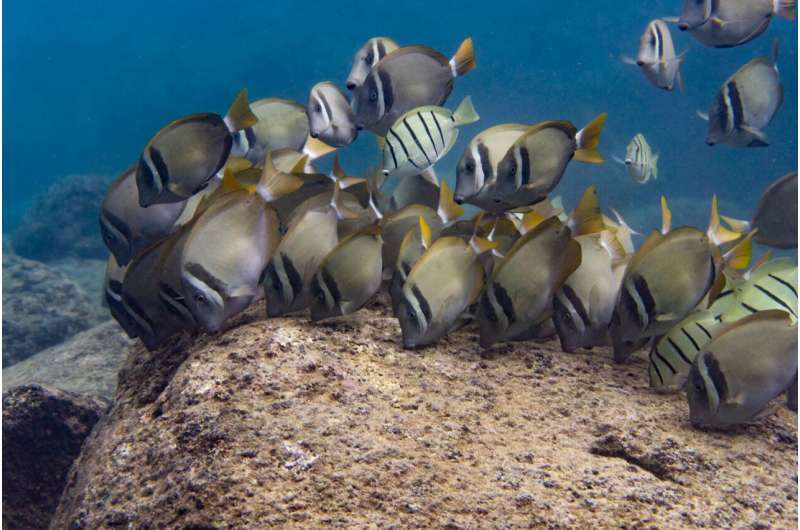This article has been reviewed according to Science X's editorial process and policies. Editors have highlighted the following attributes while ensuring the content's credibility:
fact-checked
peer-reviewed publication
trusted source
proofread
New research reveals a fishing threshold for reef resilience

Coral reefs are the most biodiverse systems in the sea and central to the life of many coastal human communities. Half a billion people rely on coral reefs for protection from storms, provision of seafood as well as promotion of tourism and recreation.
But climate change is compromising the health of coral reefs globally. Increasing sea temperatures are driving coral bleaching and death. So, the resilience of reefs in the face of climatic challenges is crucial to our collective future, and new research led by Arizona State University has delivered greater understanding of a key aspect of reef health.
In a paper published on December 6, 2023, in Proceedings of the Royal Society B, ASU Assistant Professor Mary Donovan and colleagues report that the fishing of herbivore species such as surgeonfishes and parrotfishes to less than 80% of their unfished local density compromises reef resilience through the overgrowth of algae that these fish consume.
"Many mechanisms and processes are involved in the relationship between corals and algae. But the two compete for space, and herbivores play a key role in maintaining balance," Donovan says. "If herbivore abundance is too low, algae can grow uncontrollably and cause numerous negative effects on corals."
While other factors can compromise reef resilience, such as land-based pollution running off into the ocean, this new study clearly shows that herbivorous fish populations are critical for ensuring the future of reefs and the benefits they provide to people.
The research was conducted through the Hawai'i Monitoring and Reporting Collaborative, or HIMARC, and it drew on more than 20,000 surveys across Hawai'i. The work produced results for every reef around the state—approximately 130,000 sites in total. Donovan says such comprehensive coverage represents a first.
"HIMARC is special in that it's a collaboration among all organizations that monitor the nearshore areas of Hawai'i," she says. "There are many datasets on Hawai'i's reefs, but prior to being combined by HIMARC they were each from different places. Plus, there were many locations with little or no data, so the story for the entire state could not be told."
HIMARC's work fills these gaps and creates consensus around the condition of Hawai'i's reefs that are directly applicable to management and policy. In terms of policy, the timing of this research is remarkable because a final decision about new statewide fisheries management rules for herbivores is expected on December 8th.
"The decision process, led by Hawai'i's Division of Aquatic Resources, has taken more than two years to complete with extensive community engagement," Donovan says. "And it's the first time in a very long time that new statewide fisheries regulations are on the table. So, we are addressing a vital issue for Hawai'i with a message that is imperative to communicate to both decision-makers and the public."
Moving forward, HIMARC is continuing to study the condition of Hawai'i's reefs, including indicators like overall fish diversity and biomass. They are also investigating the role of herbivores in mediating reef resilience after marine heat waves that cause coral bleaching and mortality. They want to determine whether reefs with more herbivores have better outcomes.
"Herbivores play critical roles in the ecosystem, so their function needs to be supported to ensure a future for our reefs," Donovan says. "At the same time, fishing is incredibly important to the people of Hawai'i, so the ecosystem role of herbivores must be balanced with maintaining access to fishing. Our results show that herbivores are in high abundance in some places and those reefs are healthy. But that is not true everywhere, so fishing sustainably will help ensure that healthy places stay healthy and that degraded places can recover."
Data for HIMARC's comprehensive study came from the Coral Reef Assessment and Monitoring Program (CRAMP) at the University of Hawai'i, the National Oceanic and Atmospheric Administration (NOAA), the US National Coral Reef Monitoring Program, the State of Hawai'i Division of Aquatic Resources, the University of Hawai'i Fisheries Ecology Research Laboratory including data from NOAA's Fish Habitat Utilization Study, the US National Park Service and The Nature Conservancy Hawai'i.
More information: Mary K. Donovan et al, Evidence for managing herbivores for reef resilience, Proceedings of the Royal Society B: Biological Sciences (2023). DOI: 10.1098/rspb.2023.2101
Journal information: Proceedings of the Royal Society B
Provided by Arizona State University




















